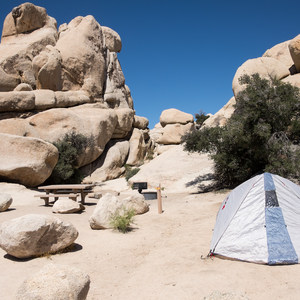The Joshua Tree Traverse is a 39-mile point-to-point route through Joshua Tree National Park. Starting from the Black Rock Campground, the route follows the California Riding and Hiking Trail to the North Entrance Station of the park. It features iconic desert vegetation including a variety of cacti, several clusters of unique rock and boulder formations, and stunning viewpoints. Joshua National Park is easily accessible from many major cities, including Los Angeles, San Diego, Las Vegas, and Phoenix and is a popular location for trail running, hiking, backpacking, rock climbing, and cycling.
A wide variety of habitats and wildlife can be found in the park, which features both the Mojave and Colorado deserts, and an elevation range of 536 ft. to 5,814 ft. The park is home to 48 different species of reptiles and 57 mammals including coyotes, foxes, bobcats, bighorn sheep. 26 species of snakes (including 7 species of rattlesnakes!), and the rare desert tortoise (which is now classified as a federally threatened species).
Joshua Tree Traverse is a premier backpacking/trail running route that provides an excellent overview of the entire area. A number of trailheads intersect this route, so it is possible to shorten or extend the distance of the trail according to your preference.
DIRECTION
Most people complete this route by traversing west to east and arranging a shuttle. Although the trail can be completed either way, traveling east provides slightly more downhill terrain.
WATER
There is no reliable water along the route, however, you are allowed to cache water for multi-day trips. Make sure to label your cache and include your name, email, and/or telephone number so that park rangers can contact you if necessary.
CAMPING AND BACKPACKING
There are numerous campgrounds located within the park. Many of them require advanced reservation and some are first-come-first-serve. For information about reservations please visit www.recreation.gov.
Backcountry camping is permitted in certain areas with regulations in place to protect the fragile desert environment. If you are planning to camp in the backcountry make sure you set up at least 1 mile from any roads, 500 feet from trails and water, and away from day-use only areas.
Backcountry campers must make sure to register at one of the stations throughout the park. For more information please visit https://www.nps.gov/jotr/planyourvisit/backpacking.htm.
CYCLING
Biking is only allowed on roads open to vehicles within the park.
FEES
National park fees are required for entrance into the park, this applies to travelers entering the park in a vehicle as well as on foot or by bike. More information, and current prices can be found at https://www.nps.gov/jotr/planyourvisit/basicinfo.htm.
SEASON
The park is open year-round, however, the busiest months are October - May.
CURRENT WEATHER CONDITIONS: https://forecast.weather.gov/MapClick.php?zoneid=CAZ560.
ADDITIONAL INFORMATION
For more information about the park, rules, and regulations please visit: https://www.nps.gov/jotr/planyourvisit/basicinfo.htm.






























Comments
Sign In and share them.